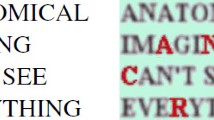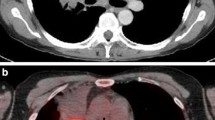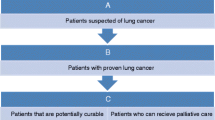Abstract
Primary pediatric lung tumors are uncommon and have many overlapping clinical and imaging features. In contrast to adult lung tumors, these rare pediatric neoplasms have a relatively broad histologic spectrum. Informed by a single-institution 13-year retrospective record review, we present an overview of the most common primary pediatric lung neoplasms, with a focus on the role of positron emission tomography (PET), specifically 18F-fluorodeoxyglucose (FDG) PET and 68Ga-DOTATATE PET, in the management of primary pediatric lung tumors. In addition to characteristic conventional radiographic and cross-sectional imaging findings, knowledge of patient age, underlying cancer predisposition syndromes, and PET imaging features may help narrow the differential. While metastases from other primary malignancies remain the most commonly encountered pediatric lung malignancy, the examples presented in this pictorial essay highlight many of the important conventional radiologic and PET imaging features of primary pediatric lung malignancies.
Graphical Abstract











Similar content being viewed by others
Data availability
The imaging datasets generated, analyzed, and presented during the current study are available from the corresponding author upon request.
Change history
13 February 2024
A Correction to this paper has been published: https://doi.org/10.1007/s00247-024-05867-y
References
Orman G, Masand P, Hicks J et al (2020) Pediatric thoracic mass lesions: beyond the common. Eur J Radiol Open 7:100240
Weldon CB, Shamberger RC (2008) Pediatric pulmonary tumors: primary and metastatic. Semin Pediatr Surg 17:17–29
Fujimoto K, Hara M, Tomiyama N et al (2014) Proposal for a new mediastinal compartment classification of transverse plane images according to the Japanese Association for Research on the Thymus (JART) General Rules for the Study of Mediastinal Tumors. Oncol Rep 31:565–572
Lee EY (2009) Evaluation of non-vascular mediastinal masses in infants and children: an evidence-based practical approach. Pediatr Radiol 39(Suppl 2):S184-190
Ranganath SH, Lee EY, Restrepo R, Eisenberg RL (2012) Mediastinal masses in children. AJR Am J Roentgenol 198:W197-216
Thacker PG, Mahani MG, Heider A, Lee EY (2015) Imaging evaluation of mediastinal masses in children and adults: practical diagnostic approach based on a new classification system. J Thorac Imaging 30:247–267
Lichtenberger JP 3rd, Biko DM, Carter BW, Pavio MA, Huppmann AR, Chung EM (2018) Primary lung tumors in children: radiologic-pathologic correlation from the radiologic pathology archives. Radiographics 38:2151–2172
Rojas Y, Shi YX, Zhang W et al (2015) Primary malignant pulmonary tumors in children: a review of the national cancer data base. J Pediatr Surg 50:1004–1008
Travis WD, Brambilla E, Nicholson AG, Panel WHO et al (2015) The 2015 World Health Organization Classification of Lung Tumors: impact of genetic, clinical and radiologic advances since the 2004 classification. J Thorac Oncol 10:1243–1260
Coffin C (2002) Inflammatory myofibroblastic tumour: World Health Organization classification of tumours. In: CDM F, F M (eds) World Health Organization classification of tumours pathology and genetics of tumours of soft tissue and bone. IARC Press, Lyon
Yu DC, Grabowski MJ, Kozakewich HP et al (2010) Primary lung tumors in children and adolescents: a 90-year experience. J Pediatr Surg 45:1090–1095
Dishop MK, Kuruvilla S (2008) Primary and metastatic lung tumors in the pediatric population: a review and 25-year experience at a large children’s hospital. Arch Pathol Lab Med 132:1079–1103
Smith NJ, Mukherjee D, Wang Y et al (2021) Epidemiology and outcomes of primary pediatric lung malignancies: updates from the SEER database. Am J Surg 222:861–866
Wang L, Tang G, Hu K et al (2022) Comparison of (68)Ga-FAPI and (18)F-FDG PET/CT in the evaluation of advanced lung cancer. Radiology 303:191–199
Huang R, Pu Y, Huang S et al (2022) FAPI-PET/CT in cancer imaging: a potential novel molecule of the century. Front Oncol 12:854658
Hicks RJ, Roselt PJ, Kallur KG et al (2021) FAPI PET/CT: will it end the hegemony of (18)F-FDG in oncology? J Nucl Med 62:296–302
Voss SD (2019) Functional and anatomical imaging in pediatric oncology: which is best for which tumors. Pediatr Radiol 49:1534–1544
Lassmann M, Treves ST (2014) Pediatric Radiopharmaceutical Administration: harmonization of the 2007 EANM Paediatric Dosage Card (version 1.5.2008) and the 2010 North American Consensus guideline. Eur J Nucl Med Mol Imaging 41 1636
Treves ST, Gelfand MJ, Fahey FH, Parisi MT (2016) 2016 update of the North American Consensus Guidelines for pediatric administered radiopharmaceutical activities. J Nucl Med 57:15N-18N
Hope TA, Allen-Auerbach M, Bodei L et al (2023) SNMMI procedure standard/EANM practice guideline for SSTR PET: imaging neuroendocrine tumors. J Nucl Med 64:204–210
Grootjans W, Rietbergen DDD, van Velden FHP (2022) Added value of respiratory gating in positron emission tomography for the clinical management of lung cancer patients. Semin Nucl Med 52:745–758
Karnak I, Senocak ME, Ciftci AO et al (2001) Inflammatory myofibroblastic tumor in children: diagnosis and treatment. J Pediatr Surg 36:908–912
Rich BS, Fishbein J, Lautz T et al (2022) Inflammatory myofibroblastic tumor: a multi-institutional study from the Pediatric Surgical Oncology Research Collaborative. Int J Cancer 151:1059–1067
Freud E, Bilik R, Yaniv I et al (1991) Inflammatory pseudotumor in childhood. A diagnostic and therapeutic dilemma. Arch Surg 126:653–655
Agrons GA, Rosado-de-Christenson ML, Kirejczyk WM et al (1998) Pulmonary inflammatory pseudotumor: radiologic features. Radiology 206:511–518
Doroudinia A, Kaghazchi F, Mehrian P, Dorudinia A (2018) Recurrent inflammatory myofibroblastic tumour of the lung: FDG PET/CT scan findings. BMJ Case Rep 2018
Mosse YP, Voss SD, Lim MS et al (2017) Targeting ALK with crizotinib in pediatric anaplastic large cell lymphoma and inflammatory myofibroblastic tumor: a children’s oncology group study. J Clin Oncol 35:3215–3221
Dehner LP, Schultz KA, Hill DA (2019) Pleuropulmonary blastoma: more than a lung neoplasm of childhood. Mo Med 116:206–210
Gbande P, Abukeshek T, Bensari F, El-Kamel S (2021) Pleuropulmonary blastoma, a rare entity in childhood. BJR Case Rep 7:20200206
Herman TE, Siegel MJ (2008) Neonatal pleuropulmonary blastoma, type 1. J Perinatol 28:82–84
Schultz KA, Yang J, Doros L et al (2014) DICER1-pleuropulmonary blastoma familial tumor predisposition syndrome: a unique constellation of neoplastic conditions. Pathology case reviews 19:90
Naffaa LN, Donnelly LF (2005) Imaging findings in pleuropulmonary blastoma. Pediatr Radiol 35:387–391
Bueno MT, Martinez-Rios C, la Puente GA et al (2017) Pediatric imaging in DICER1 syndrome. Pediatr Radiol 47:1292–1301
Feinberg A, Hall NJ, Williams GM et al (2016) Can congenital pulmonary airway malformation be distinguished from type I pleuropulmonary blastoma based on clinical and radiological features? J Pediatr Surg 51:33–37
Miniati DN, Chintagumpala M, Langston C et al (2006) Prenatal presentation and outcome of children with pleuropulmonary blastoma. J Pediatr Surg 41:66–71
Knight S, Knight T, Khan A, Murphy AJ (2019) Current management of pleuropulmonary blastoma: a surgical perspective. Children (Basel) 6
Ruan D, Sun L (2021) Case report: Pleuropulmonary blastoma in a 2.5-year-old boy: 18F-FDG PET/CT findings. Frontiers in Nuclear Medicine 1
Hagedorn KN, Nelson AT, Towbin AJ et al (2023) Assessing the role of positron emission tomography and bone scintigraphy in imaging of pleuropulmonary blastoma (PPB): a report from the International PPB/DICER1 Registry. Pediatr Blood Cancer 70:e30628
Potter SL, HaDuong J, Okcu F et al (2019) Pediatric bronchial carcinoid tumors: a case series and review of the literature. J Pediatr Hematol Oncol 41:67–70
Jeung MY, Gasser B, Gangi A et al (2002) Bronchial carcinoid tumors of the thorax: spectrum of radiologic findings. Radiographics 22:351–365
Moore W, Freiberg E, Bishawi M et al (2013) FDG-PET imaging in patients with pulmonary carcinoid tumor. Clin Nucl Med 38:501–505
Deleu AL, Laenen A, Decaluwe H et al (2022) Value of [(68)Ga]Ga-somatostatin receptor PET/CT in the grading of pulmonary neuroendocrine (carcinoid) tumours and the detection of disseminated disease: single-centre pathology-based analysis and review of the literature. EJNMMI Res 12:28
Johnbeck CB, Mortensen J (2021) Somatostatin receptor imaging PET in neuroendocrine neoplasm. PET Clin 16:191–203
Vesterinen T, Leijon H, Mustonen H et al (2019) Somatostatin receptor expression is associated with metastasis and patient outcome in pulmonary carcinoid tumors. J Clin Endocrinol Metab 104:2083–2093
Jiang Y, Hou G, Cheng W (2019) The utility of 18F-FDG and 68Ga-DOTA-peptide PET/CT in the evaluation of primary pulmonary carcinoid: a systematic review and meta-analysis. Medicine (Baltimore) 98:e14769
Kim TS, Lee KS, Han J et al (1999) Mucoepidermoid carcinoma of the tracheobronchial tree: radiographic and CT findings in 12 patients. Radiology 212:643–648
Lee EY, Vargas SO, Sawicki GS et al (2007) Mucoepidermoid carcinoma of bronchus in a pediatric patient: (18)F-FDG PET findings. Pediatr Radiol 37:1278–1282
Suzuki M, Koyama R, Uchida Y et al (2020) Primary adenoid cystic carcinoma of the lung in 14-year-old boy. J Pediatr Surg Case Rep 56:101432
Seedat RY (2020) Juvenile-onset recurrent respiratory papillomatosis diagnosis and management - a developing country review. Pediatric Health Med Ther 11:39–46
Gelinas JF, Manoukian J, Cote A (2008) Lung involvement in juvenile onset recurrent respiratory papillomatosis: a systematic review of the literature. Int J Pediatr Otorhinolaryngol 72:433–452
Fortes HR, von Ranke FM, Escuissato DL et al (2017) Recurrent respiratory papillomatosis: a state-of-the-art review. Respir Med 126:116–121
Bair RJ, Chick JF, Chauhan NR et al (2014) Demystifying NUT midline carcinoma: radiologic and pathologic correlations of an aggressive malignancy. AJR Am J Roentgenol 203:W391-399
Sholl LM, Nishino M, Pokharel S et al (2015) Primary pulmonary NUT midline carcinoma: clinical, radiographic, and pathologic characterizations. J Thorac Oncol 10:951–959
Xie XH, Wang LQ, Qin YY et al (2020) Clinical features, treatment, and survival outcome of primary pulmonary NUT midline carcinoma. Orphanet J Rare Dis 15:183
Chau NG, Hurwitz S, Mitchell CM et al (2016) Intensive treatment and survival outcomes in NUT midline carcinoma of the head and neck. Cancer 122:3632–3640
Rosenbaum DG, Teruya-Feldstein J, Price AP et al (2012) Radiologic features of NUT midline carcinoma in an adolescent. Pediatr Radiol 42:249–252
Batziou C, Stathopoulos GP, Petraki K et al (2006) Primitive neurectodermal tumors: a case of extraosseous Ewing’s sarcoma of the small intestine and review of the literature. J BUON 11:519–522
Chow E, Merchant TE, Pappo A et al (2000) Cutaneous and subcutaneous Ewing’s sarcoma: an indolent disease. Int J Radiat Oncol Biol Phys 46:433–438
Moustafellos P, Gourgiotis S, Athanasopoulos G et al (2007) A spontaneously ruptured primitive neuroectodermal tumor/extraosseous Ewing’s sarcoma of the kidney with renal vein tumor thrombus. Int Urol Nephrol 39:393–395
Ling X, Tong J, Wang L et al (2021) Primary pulmonary Ewing’s sarcoma: rare cause of massive hemothorax in a young girl-case report. BMC Pediatr 21:194
Zhang J, Dong A, Cui Y, Wang Y (2019) FDG PET/CT in a case of primary pulmonary Ewing sarcoma. Clin Nucl Med 44:666–668
Cederberg KB, Iyer RS, Chaturvedi A et al (2023) Imaging of pediatric bone tumors: a COG Diagnostic Imaging Committee/SPR Oncology Committee white paper. Pediatr Blood Cancer 70:e30000
Abele M, Bajciova V, Wright F et al (2022) Primary lung carcinoma in children and adolescents: an analysis of the European Cooperative Study Group on Paediatric Rare Tumours (EXPeRT). Eur J Cancer 175:19–30
Balzer BWR, Loo C, Lewis CR et al (2018) Adenocarcinoma of the lung in childhood and adolescence: a systematic review. J Thorac Oncol 13:1832–1841
Sheikhbahaei S, Mena E, Yanamadala A et al (2017) The value of FDG PET/CT in treatment response assessment, follow-up, and surveillance of lung cancer. AJR Am J Roentgenol 208:420–433
Author information
Authors and Affiliations
Contributions
SDV conceived, supervised, and supported the study.
KKS and SDV contributed to data collection and manuscript preparation.
CBW and SDV confirmed correlative radiologic, clinical, and pathologic data.
All authors reviewed and approved the final manuscript.
Corresponding author
Ethics declarations
Not applicable.
Conflicts of interest
None
Additional information
Publisher's Note
Springer Nature remains neutral with regard to jurisdictional claims in published maps and institutional affiliations.
The original online version of this article was revised: The originally published article contains errors.
1. All instances of “68Ga” should have no space.
2. Figures 4d, 5a, 9d and 10c has been updated (alignment of the sub-figures)
Supplementary Information
Below is the link to the electronic supplementary material.
247_2023_5847_MOESM1_ESM.tif
Supplementary file1 (TIF 11355 KB) Online Resource 1. Type 1 Pleuropulmonary Blastoma in a 2 month old boy. AP chest radiograph (A) shows multiple thin-walled coalescent lung cysts, thought to be congenital pulmonary airway malformation based on prenatal imaging. Axial CT (B) of the chest confirms large thin-walled cysts with septations. Based on the predominantly cystic appearance with no solid elements detected, PET imaging was not performed. Following surgical resection pathology confirmed type 1 pleuropulmonary blastoma.
247_2023_5847_MOESM2_ESM.tif
Supplementary file2 (TIF 13464 KB) Online Resource 2. Type 2 pleuropulmonary blastoma in a newborn with prenatally diagnosed lung cyst. Newborn girl with prenatally diagnosed lung cyst showing progressive enlargement of multi-loculated lung cysts on CXR obtained at 1 month of age (A) and 3 months of age (B), with a possible solid nodule seen at 3 months (B, arrow). Coronal CT images reconstructed in soft tissue (C) and lung windows (D) demonstrate the multi-loculated lung cysts with thin septations and confirm the presence of a solid mass (arrow) associated with the predominantly cystic lung lesion. Based on the progressive enlargement of the mass the patient underwent surgical resection and a staging PET/CT was not performed. Pathology confirmed a mixed cystic and solid type 2 pleuropulmonary blastoma.
247_2023_5847_MOESM3_ESM.tif
Supplementary file3 (TIF 11956 KB) Online Resource 3. Endobronchial Carcinoid. 16 year-old girl with persistent cough and left lower lobe opacity on PA chest radiograph (A, arrow) that failed to clear with appropriate anti-microbial treatment. Coronal contrast-enhanced CT (B) revealed an enhancing endobronchial lesion in the left lower lobe (asterisk) with a larger extra-bronchial component (arrow) that included heterogeneously enhancing tumor and post-obstructive collapsed lung, corresponding to the left lower lobe opacity seen radiographically. Based on the CT appearance no additional imaging was performed and the patient underwent left lower lobectomy. Pathology revealed low-grade carcinoid.
247_2023_5847_MOESM4_ESM.tif
Supplementary file4 (TIF 15190 KB) Online Resource 4. 18F-FDG PET/CT imaging of Mucoepidermoid Carcinoma. Frontal chest radiograph (A) from a 15-year-old girl with fever, cough and hemoptysis shows a well-defined nodular opacity in the right perihilar region (solid arrow). Corresponding axial CT image (B) demonstrates a well-defined intraparenchymal lesion in posterior segment of right upper lobe, in close association with the upper lobe bronchus (open arrow). Coronal MIP image from 18F-FDG PET/CT (C) shows moderate uptake in the right upper lobe lesion (solid arrow), with no FDG-avid disease elsewhere. Pathology revealed well-differentiated mucoepidermoid carcinoma arising from a right upper lobe bronchus. (Reproduced with permission from Lee et al. [48])
247_2023_5847_MOESM5_ESM.tif
Supplementary file5 (TIF 14198 KB) Online Resource 5. 18F-FDG PET/CT staging of NUT Carcinoma. 9 year old girl presenting with joint pain and abdominal pain. Radiographs of the right knee (A, arrows) show periosteal reaction with an infiltrative bone lesion; bone marrow biopsy showed NUT carcinoma. Staging axial and coronal contrast enhanced chest CT (B, C) and coronal MIP image from whole body 18F-FDG PET/CT (D) demonstrate mediastinal and left hilar (B, arrows) soft tissue mass with extension into the left lower lobe (C, open arrow). 18F-FDG PET imaging shows widespread metastatic disease throughout the axial and appendicular skeleton (dashed arrows) in addition to uptake at the sites of mediastinal and lung involvement seen by CT.
Rights and permissions
Springer Nature or its licensor (e.g. a society or other partner) holds exclusive rights to this article under a publishing agreement with the author(s) or other rightsholder(s); author self-archiving of the accepted manuscript version of this article is solely governed by the terms of such publishing agreement and applicable law.
About this article
Cite this article
Shashi, K.K., Weldon, C.B. & Voss, S.D. Positron emission tomography in the diagnosis and management of primary pediatric lung tumors. Pediatr Radiol 54, 671–683 (2024). https://doi.org/10.1007/s00247-023-05847-8
Received:
Revised:
Accepted:
Published:
Issue Date:
DOI: https://doi.org/10.1007/s00247-023-05847-8




